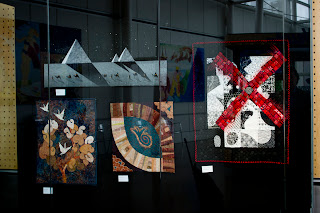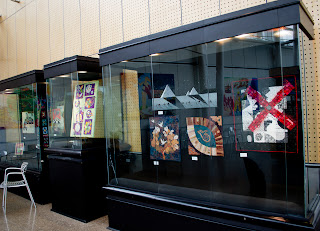You might want to start with a little history and look at Designing for a Theme: Innovation Part 1.
 |
| Artist rendition of Graphene molecules |
With the topic “Fiber Artists Look at Innovation and Civic Action”, I personally decided to narrow down possibilities by choosing to represent innovation. Since I’ve always enjoyed science, I started with looking at scientific journals and find out what some of the recent innovations have been that are expected to revolutionize areas of our lives. This is where I found out about Graphene.
Graphene, a form of carbon only one atom thick and in a hexagonal cellular structure, is both the thinnest and strongest substance now known to man. Scientists believe it will revolutionize technology from computer and mobile displays, medical devices, aerospace, desalination plants, electronics and countless ways which we cannot yet predict. Since I’m a technology fan and my husband’s business is in aerospace, this seemed like a good place to start. If you want to see a really cool futuristic video, check out this short YouTube “Future Applications of Graphene.”
So now I had a topic to try to represent to go along with the theme… but what could I do with it? I decided I wanted to represent both the uniqueness of the material (thin, lightweight, hexagonal cellular structure) as well as some of the possible applications of the technology.
Another little aspect that I had to keep in mind was the unusual gallery space that this piece would (hopefully) be hanging in. The walls were mostly all a deep dark forest green (with a hint of teal) and a couple that were a bright spring green. Not exactly easy to hang anything on, but ok if you’re specifically designing for the backdrop color.
My idea was to have a thin sheer layer cut in a hexagonal pattern that would fiat above the quilt, which would be surfaced designed to tell more of the story. I started the quilted layer with white Pima cotton. I bought some plasticized wire garden fencing that had hexagons as its design, and started with placing it on top of the white fabric and spritzed jacquard Textile Paint through it. This created a resist, with a painted background (in blues and greens) with a shadowy faint white hexagonal grid.
 |
| Representation of a computer touch-screen made with a thermofax silkscreen and hand-painted shading |
I then created several black and white images from photos (using Photoshop) of things that will have future applications using graphene. These included a commercial airplane, computer circuit boards, a smartphone, and a computer touchscreen. I then turned these images into silkscreens using a thermofax machine. I layered these different images around on the background, using Versatex print ink. I added some hand painting and when the paints were all dry, I finished the back/quilt with a diamond grid pattern for the quilting, as well as freemotion elements around each of the special elements.
 |
| Silkscreened computer circuit board with gold metallic thread freemotion quilted to look like metal elements. |
Now it was time to figure out how to represent the one-atom thick sheets of this hexagonal carbon molecule. I knew I wanted to have it be somewhat sheer (and black, since it is carbon, after all.) I thought that using a black organza might get the effect I wanted, so I bought some of each silk, rayon, nylon and polyester organza to test. I had a couple of different ideas on how to cut out a grid that wouldn’t ravel and could hold up, yet not be too terribly difficult or end up too uneven.
 |
| Some of my samples testing different organzas and ways to cut and make sure they wouldn’t fray |
The most consistent method and material turned out to be painting the nylon organza with matte medium, drying it, and cutting out the interior hexagons with small, sharp scissors. I’d been a bit surprised by this, thinking that a hot knife might cut and melt a synthetics edges at the same time, but it proved to be more difficult and harder to be exact than using my small Kai scissors. Also, I tried treating with different products with varying degrees of success. Some items made the organza too stiff (I wanted it still to be able to move in a breeze, to demonstrate the thinness of the graphene); others, like Fray Check, left a shiny plastic-like coating.
 |
| Close-up of grommet, copper pipe & bead hanging mechanism |
 |
| The organza hanging |
You can imagine the time it took me to cut out each of the little hexagons on the finished piece! The next step was to figure out how to affix the top layer so it would hang out separately from the quilted back piece. This turned out to be quite tricky. After many trials and errors, I was able to get a decent effect using some heavy-duty grommets, 1/8″ copper piping, copper wire, and beads.
Thankfully, my efforts were rewarded by the jury and my piece was accepted into the show! Here is the final piece, hanging at the Seattle Center Next 50 Exhibition! I particularly like how the hanging grid creates such interesting shadows with the gallery lighting. The only disappointment to me was that the show chair who mapped out where each piece was to go, choose to put my piece on one of the couple spring green walls, after I’d designed it to go on the dark green ones! Well, you can’t control everything!
You might also be interested in:
 |
 |
 |
| Designing for a Theme… Innovation Part 1 |
Designing for a Theme | Journeys Show at SeaTac Airport |
 I’ve been thinking once again about designing with a specific theme in mind. If you have entered into juried shows that have a theme, you know the dilemma. How literal do I need to make this piece to fit the theme? Or perhaps you’ve just skipped entering those shows.
I’ve been thinking once again about designing with a specific theme in mind. If you have entered into juried shows that have a theme, you know the dilemma. How literal do I need to make this piece to fit the theme? Or perhaps you’ve just skipped entering those shows.
 Since my preferred style in which to make art is representational or pictorial, I don’t usually have a great difficulty with making something to fit a theme. My struggle is more about whether I really want to make a piece or not for that show.
Since my preferred style in which to make art is representational or pictorial, I don’t usually have a great difficulty with making something to fit a theme. My struggle is more about whether I really want to make a piece or not for that show.
As an example, I’d like to share about the 50th Anniversary Celebration of the Seattle Center. In 1962, Seattle was the home of the World’s Fair… the grounds on which the fair was held is the Seattle Center. Most notably, Seattle’s best-known landmark, the Space Needle was built for this 6 month festival and exhibition.
 |
| Helen Remick’s “Spinning Out, Spinning In 1” (left) and Margaret Liston’s “Save” (right) |
Seattle Center put out a call to artists for large proposals to show during the 6 months of the Next 50 Celebration. The theme of the overall exhibit and performances was “Illuminating Today’s Challenges, Imagining Tomorrow’s Possibilities.” The call was set up as a two-tier process. You sent in an extensive original proposal through Café (Call for Entry), including a series of images representative of your art.
As I am the Exhibitions Co-Chair of the Contemporary QuiltArt Association, I prepared this proposal for our group. The second tier was like a call-back for an audition. Except now, you had to do an elaborate proposal, including budget, recommendations on where within the Seattle Center grounds that your exhibit would take place, showing how your art would benefit and reflect the theme of the Next Fifty, and finally a video to support your claims of your work.
 |
| Melisse Laing’s “Sorok dva – Russian Collaboration II” |
In the end, we did get chosen for an exhibition, but we did not receive any of the grant money… not a big problem as our group doesn’t typically get paid to exhibit. But when it came down to the “theme”, they decided they wanted to be even more specific. The dates chosen for our group’s exhibition were during September and October (2012). Each month of the celebration had a focus… September’s theme was “Commerce and Innovation” and October’s was “Civic Action.” So, the name given for our exhibit was “Possibilities: Fiber Artists Look at Innovation and Civic Action.” Can you imagine trying to get a group of quilt artists to tackle that as a theme? (Imagine a great big eye-rolling from me here.)
 |
| Artist and CQA President Marylee Drake with her piece “Gearing Up for the Future” |
But, somehow our artists always come through with a wonderful show as you can see from the photos above. Tomorrow, I’ll talk about and share some photos of the process I went through to make my piece “Graphene – The Miracle Material.”
You might also be interested in:
Designing for a Theme
A Day of Art
Making Fabric
Do you shudder with fear or turn away with disdain when you see a show that has a theme? It seems that many calls to artists request the artwork to meet an aspect of a theme, and some jurors are stricter than others about how closely a piece meets that criteria or not.
 |
| Moulin Rouge Deux (on right) at the Airport Appetizer show |
As the Co-chair for Exhibitions for the Contemporary QuiltArt Association, I’ve seen both jurors who would drop a piece for not seeming to have anything to do with a theme, and others who were open to a very broad interpretation (such as the title had a word that related to the theme, but there was no other discernible connection.)
Being more of a representational artist, working with a theme usually works well for me. I like having a launching pad for my ideas. For instance, at one show at the SeaTac international airport, my quilt “Moulin Rouge Deux” was displayed, along with other quilts with international elements. You can clearly see the pyramids in the other quilt alongside mine.
Currently, SeaTac has another exhibit from CQA, this one with the name and theme of “Journeys.” In this show, we had some fabulous entries which took many different interpretations of the theme. I have two additional pieces in this show. Here are some photos from this exhibit:
Many interpretations of a broad theme. After all, we can take literal journeys, by foot, car, horse, rail, air, boat, etc. or we can take spiritual journeys, journeys of the heart, or journeys of our imagination.
 |
| Rainier: Two Views by Colleen Wise |
But what about when the theme is more difficult or restrictive? I’ll go into that more tomorrow. Pleasant dreams…yet another type of journey!









